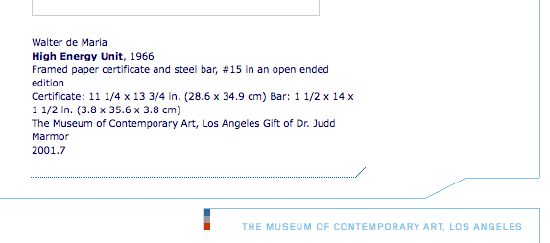
See what happens when you just ask? My posts the last couple of days about [mis]remembering Walter de Maria’s 1966 stainless steel sculpture, High Energy Bar/ High Energy Unit, is shaking loose some interesting bits of information on the work and the burst of popularity of “multiples” as a democratic, anti-elitist, market-thwarting strategy for artmaking in the 1960s. [I’m sure there are enough unsupported assumptions packed into that sentence to make a whole CAA-ful of art historians’ eyes bleed, but whatever, close enough.]
First up, de Maria discussed High Energy Bar with Paul Cummings in 1972, in his interview for the Smithsonian Archive:
WDM: …But I mean there’s some relationship between being able to go smaller and smaller through the electron microscope and at the same time still not be able to see all the galaxies in outer space. But I do think that in ten or twenty years somebody will say, well, that’s a minimal situation, or that’s a minimal or that’s minimal art. I think that that will stand. The point was that in the development of these boxes and rectangles it wasn’t just making another piece of geometric sculpture, because there’s been a lot of geometric sculpture in the last fifty years, but of the relationship between this angle and that angle or this box and that box or even David Smith’s last sculptures, you know, the boxes and cubes which in a way was a sort of three-dimensional cubism some sixty or seventy years later, fifty years later, or whatever. But, it was the idea that you could take a perfect cube, perfect rectangle such as the high energy bar, the perfect rectangle and, well, I’ll show you a high energy bar in a moment, and the notion that its ideas and its lines were so perfect and so perfectly composed and self-contained that it was perfectly satisfying to look at that one object as a sculpture without having it confused with a lot of needless relationships. It was perfectly focused on itself and implied a lot more than it was.
PC: You still make those, don’t you?
WDM: The high energy bars, yeah. I’ll make those all my life.
PC: It’s an open-ended multiple.
WDM: That’s right, and I didn’t like the word “multiple.”
PC: Did you think of them in those terms?
WDM; Well, I would say when I started making them in ’65, ’66, the ideas of multiples was just growing about that time and I thought that if a person accepted the idea of a multiple that it should be open-ended, because why, if you have mass-produced technology, why should you limit it at fifty or a hundred or two hundred, because the technology is inexpensive to make . . . .
PC: You have to want that limitation.
WDM: Yeah, and so I sort of thought if I ever did that that probably multiples should be completely continuous.
So yeah, “make those all my life,” but I also like that part up top about these perfect, reference-free metal objects and the once-future convergence of science and minimalism. The latter, of course, feels like validation of what I already think, and the former seems completely undermined by his sculptures’ formal similarities to objects like the Meter–though the PKU’s conceptual conceit that a kilogram is equal to itself does kind of close the loop nice and tightly.
Anyway, onward and upward with the arts. From a reader far more learned than myself on these matters, Kathleen Campagnolo, who is just finishing her PhD on the 1960s sculptures of Walter de Maria, and who apparently has a Google alert set for all mentions of “High Energy Bar -triathlon,” comes this:
the artist’s statement from “3 → ∞ : new multiple art,” a 1970 exhibition at the Whitechapel Gallery, which included Virginia Dwan’s example of High Energy Bar, No. 53:
High Energy Bar
Work on the High energy bar began in 1965. A summation of my minimal investigation in sculpture going back to 1961/62 – the nature of the rectangle.
First bar issued in 1966.
This is my answer to the multiple – not a multiple. I detest multiples (in art).
Differs from most multiples in several respects:
1st) Infinite edition – not limited. I shall make them all my life.
2nd) My personal connection with each bar. With each bar is issued a certificate.
I collect the following information:
Name of owner
Address
Number of bar
And after no. 50 photograph of owner.
3rd) Bars are not transferable. The bar always belongs to the person who gets it first, i.e., if after a person dies the bar were ‘given’ to someone else – that new person would have the first person’s bar – he would not have the bar for himself, i.e., it would not be his bar.
Records of the owners of the bars are kept in a Swiss bank. Needless to say the ownership of all bars is known only to myself and never divulged.
I love it, and not just because that last part, about the bars being non-transferable, makes me feel like I was kind of right all along. If anything, this just adds a new desirability factor to the High Energy Bar secondary market. They’re like Friends of Walter trading cards. Now it’s not just a question of how low the edition number is, but who the first only true owner is/was.
Also, Swiss bank!
You should be able to buy the catalogue for Three To Infinity: New Multiple Art more cheaply than these Amazon dealers [amazon]
